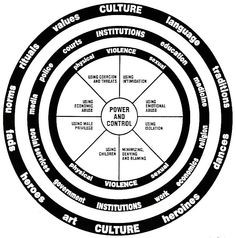Canadian society was founded on a colonialist model that supported patriarchy. Men, especially men of privilege, developed a sense of entitlement to exert power and control over certain groups, one of which included girls and women.
Men believing it’s their inherent right to use power and control over girls and women is the basis of rape culture. Historically, predominant ideas, social practices, media, government, schools, religious institutions, employers, the various levels of law enforcement and justice were established by privileged white men. All of these institutions play a role in condoning sexual assault. They accomplish this by normalizing violence against women and reinforcing the myth that the survivor is to blame. Conversely, these institutions can choose to make a difference by supporting women’s rights which, quite simply, are basic human rights.
When women are sexually assaulted men are the perpetrators 99 per cent of the time. These men come from a wide spectrum of economic, ethnic, racial, age and social backgrounds. In 80 per cent of cases the assailant was known to the survivor. These men include health professionals, police officers, military personnel, teachers, professors, employers, coworkers, religious leaders, coaches, lawyers, neighbours, dates, boyfriends, relatives and partners of the women they sexually assault. Because the survivor knows the perpetrator the assault is often not recognized as a crime by either the survivor or the rapist.
Alcohol is often blamed as a mitigating factor in rape. Clearly a double standard exists where alcohol consumption by an offender is often used to excuse their behaviour, while survivors who were drinking are blamed for their own victimization.
There is no evidence that mental illness causes men to be violent against women. Men who assault women rarely assault their friends, neighbours, bosses or strangers. A man suffering from a mental illness is unable to turn it on and off at will.
In her book, “An Analysis of Violence Against Women: A Manual for Educators and Administrators,” (Toronto: Ontario Institute for Studies in Education, 1992), Helen Lenskyj found that men who rape are not mentally ill or sexually depraved but rather ordinary men with a desire to exert power and control.
Rape is a premeditated act. Rapists choose vulnerable woman and when the opportunity arises they force her to have intercourse without consent. It is an act of violence involving power and control.
About six percent of all non-spousal rapes are reported to police. Between 96 to 98 per cent of reported rapes are true. Low reporting is often caused by a fear of:
- being labelled
- victim blaming
- not being believed
- the legal system
- repercussions from friends, family, the community or the rapist
Racialized women often have life experiences that cause greater distrust of police and the legal system. This further compounds underreporting of this crime.
A cursory examination of Canadian institutions can be enough to understand why women find it difficult to disclose sexual assault and rape.
A woman reporting a sexual assault by a health professional to police means the medical society will probably become involved. However, if the woman discloses to the medical society alone, then the governing body may not be obligated to report the crime to police.
Earlier this spring the Ontario government created the Minister’s Sexual Abuse Task Force to review the Regulated Health Professions Act, 1991. This is the third such task force in 24 years.
Task forces in 1991 and 2000 established that sexual assault of predominately women and youth by health professionals was a concern. It was also established that health professionals faced little to no retribution for their crimes. Recommendations from these task forces were never implemented. Shelving the recommendations from this most recent task force would show that the provincial government really has no interest in addressing this issue.
According to the Native Women’s Association of Canada (NWAC):
- Aboriginal women 15 years and older are 3.5 times more likely to experience violence than non-Aboriginal women
- Aboriginal women between the ages of 25 and 44 with Indian status are five times more likely than other women of the same age to die as the result of violence
- 53 per cent of murder cases in NWAC’s Sisters In Spirit database have been solved, compared to 84 per cent of all murder cases across the country
Aboriginal groups continue to request a national inquiry into the systemic causes that have led to the growing list of missing and murdered Indigenous women. While the Harper government staunchly refuses this request, Canadians are finding out the causes thanks to our media:
- An RCMP officer in northern Manitoba arrested an intoxicated Indigenous woman at a house party only to return, off duty, to request her release into his custody in or order to, “pursue a personal relationship.”
- An RCMP constable in Portage la Prairie, Manitoba, took the complaint of an Aboriginal woman who was choked, beaten, stripped, and pushed out of a house naked by her boyfriend, but refused to interview witnesses, or lay charges as per RCMP policy on domestic violence.
These stories expose the vulnerability of Native women when the institutions in charge of protecting their rights and their lives fail to do so.
Then, there’s the report prepared by former Supreme Court justice Marie Deschamps that challenges the Canadian Armed Forces zero tolerance policy for sexual harassment amidst widespread problems of sexual harassment and sexual assault. The problem is named as an imbalance of power but the recommendation that an independent body be established to review reports of sexual misconduct has not been enthusiastically adopted by military leaders. Acts of sexual harassment and assault are actually condoned by military leaders who see the army as a “reflection of society.”
Sadly, that may very well be the case.
All of this leaves me asking, who are the men that girls and women can trust? Where are the role models for our boys and young men?




